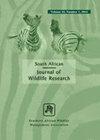Chemical Composition of African Savanna Buffalo (Syncerus caffer) Meat
引用次数: 3
Abstract
African buffaloes (Syncerus caffer) are hunted for their trophies and the meat is seen as a secondary product. Little information exists on the chemical composition of buffalo meat or the effect that sex and muscle type may have thereupon. In the present investigation, eight male and four female buffalo that were found to be positive for tuberculosis (Mycobacterium bovis) were culled and the chemical composition of their meat determined. Although male buffalo meat had higher moisture and protein than females, these differences were small and it is debatable whether a consumer would notice such differences. The amount of fat (<2 g/100g) and ash did not differ between sexes. Similarly, the differences in the proximate composition of the Biceps femoris, Longissimus dorsi and Semimembranosus muscles were all also <1 g/100 g meat. Sex had no effect on the amino acid composition of the muscles but alanine, valine and histidine content differed between muscle types although the differences were <1 g/100 g protein. The fatty acid (FA) composition did not differ between sexes or muscle type. Oleic acid was the dominant FA followed by linoleic and palmitic acids. The FA had similar ratios of saturated FA (∼38%), mono-unsaturated FA (∼31%) and poly-unsaturated FA (∼29%). The low fat to protein ratio and a poly-unsaturated to saturated FA ratio of >0.7 indicates that buffalo meat is a lean, healthy and condensed protein source.非洲热带草原野牛肉的化学成分
非洲水牛(Syncerus caffer)被猎杀作为战利品,其肉被视为次要产品。关于水牛肉的化学成分或性别和肌肉类型可能因此产生的影响的信息很少。在目前的调查中,发现结核(牛分枝杆菌)呈阳性的8头公水牛和4头母水牛被扑杀,并测定了其肉的化学成分。虽然雄性水牛肉比雌性水牛肉含有更高的水分和蛋白质,但这些差异很小,消费者是否会注意到这些差异是有争议的。脂肪含量(0.7)表明水牛肉是一种精瘦、健康和浓缩的蛋白质来源。
本文章由计算机程序翻译,如有差异,请以英文原文为准。
求助全文
约1分钟内获得全文
求助全文

 求助内容:
求助内容: 应助结果提醒方式:
应助结果提醒方式:


